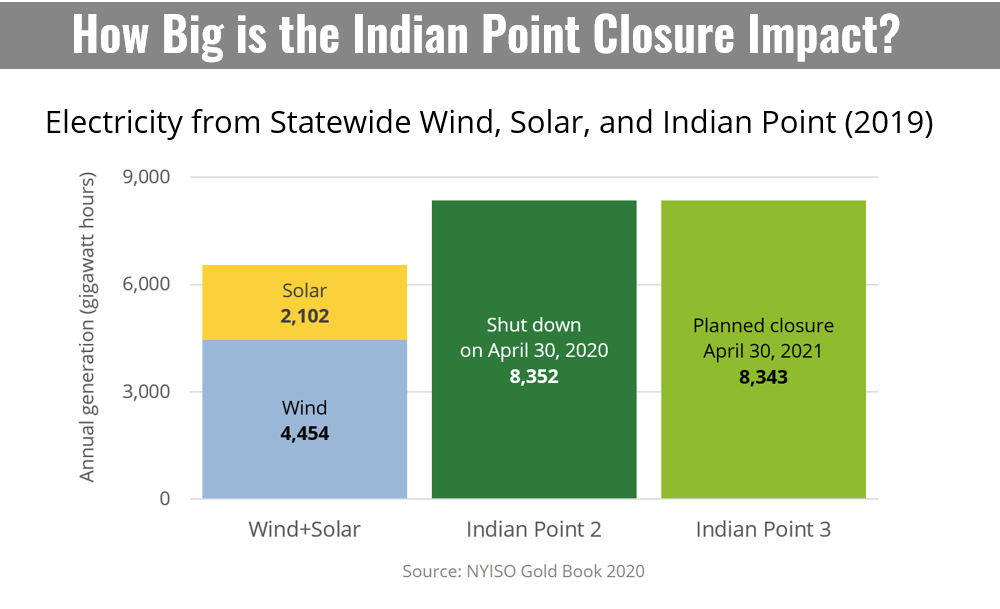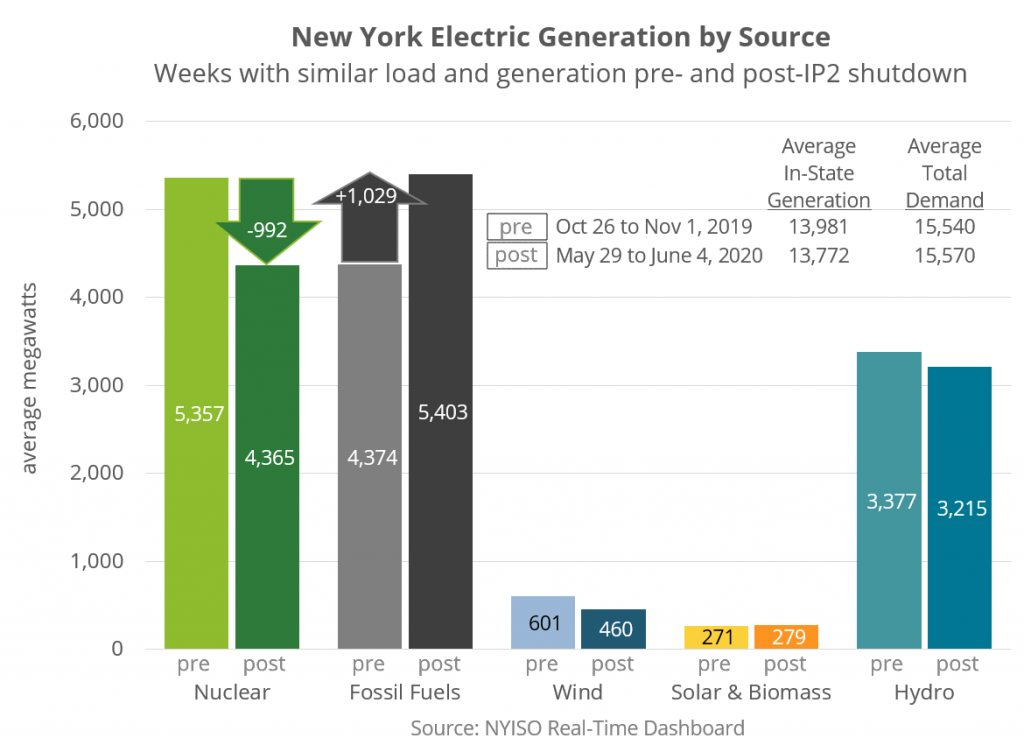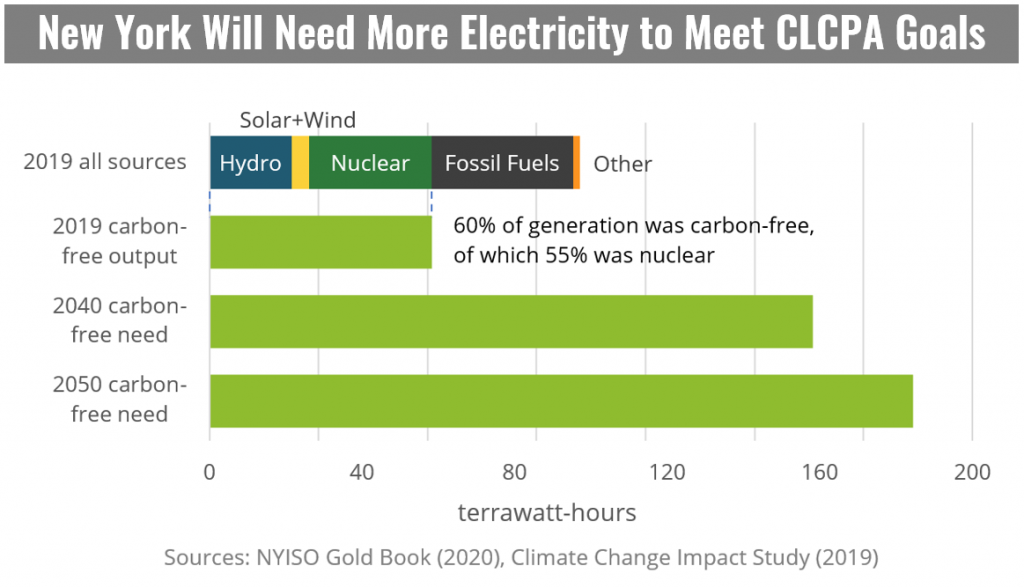
For Immediate Release: June 8, 2020
CONTACTS: Dietmar Detering info@nuclearny.org 917-251-2235
Leonard Rodberg lensqc@infoshare.org 917-601-0186
New York Negates All Wind & Solar Deployed Statewide by Closing Indian Point Reactor 2. More Fossil Fuels, More Pollution Without Nuclear Energy
Buchanan, NY – Last July, Governor Andrew Cuomo signed into law the Climate Leadership and Community Protection Act (CLCPA). The CLCPA requires that 100% of New York’s electricity be carbon free by 2040, with the aim of economy-wide decarbonization by 2050.
However, the state recently took a major step away from these ambitious goals. On April 30, 2020, New York shut down Indian Point nuclear reactor 2 (IP2), erasing more carbon-free electricity than generated annually by all of the wind and solar power (utility-scale and “behind the meter”) deployed statewide over the past 20+ years.

“It is truly short-sighted,” said Isuru Seneviratne, who researches energy investment and climate policy for Radiant Value Management. “In 2019, wind and solar in New York produced about 6,600 gigawatt-hours (GWh) of electricity. Indian Point produced 16,700 GWh. By shutting down just one half of this nuclear plant, New York did more damage to the climate than destroying every wind turbine and solar panel in the state.“
Those who rallied for the shutdown are still pondering how long it will take to “replace” the electricity from Indian Point with renewable energy (RE) and energy efficiency (EE). Data from the New York Independent System Operator (NYISO) reveals that replacement power is coming from gas. This includes new fossil fuel power plants (Cricket Valley in Dover, NY and CPV in Wawayanda, NY), as well as increased use of existing power plants in and around the New York City metropolitan area.
There is a general misconception among some environmentalists that we can delegate prior gains in RE and EE to replace electricity from Indian Point. The fact is that the benefits of renewable energy and efficiency installed before April 30th are already absorbed into the system, having been put to good use reducing the need for fossil fuels. Shutting down IP2 creates a hole in baseload generation serving the downstate region that can only be compensated by sources which were not generating electricity before IP2 closed or by running existing plants more. Installed renewables are already producing whatever electricity they can when they can, so that hole must be filled by a dispatchable source with excess capacity.

“Unfortunately, today that source is gas,” said Leonard Rodberg PhD, physicist, and Professor Emeritus of Urban Studies of Queens College/CUNY. “It is not possible to make the wind blow harder and the sun shine brighter because New York foolishly unplugged a gigawatt of carbon-free electricity. The consequence of ‘cashing in’ prior gains in RE and EE to ostensibly ‘replace’ IP2 is that previously avoided fossil fuels must now be burned.“
“We can pretend to tackle climate change as we play shell games with numbers, or we can actually do what is necessary in the real world to address this existential crisis,” added Keith Schue, electrical engineer and technical advisor for New York Energy and Climate Advocacy. “Now is not the time to be taking viable carbon-free sources of energy off the table. Every bit of renewable energy and efficiency we can marshal should go to eliminating fossil fuels, rather than shutting down another source of carbon-free power.”
Closing IP2 not only increases the state’s greenhouse gas emissions, it also exposes Environmental Justice communities to more particulate matter (PM2.5) and other pollutants that exacerbate respiratory and cardiovascular diseases, including susceptibility to COVID-19. Yet, unbelievably, instead of closing dirty inner-city power plants—like Ravenswood in Queen’s “Asthma Alley”—the state actually plans to shut down Indian Point’s other reactor, IP3, next year.
“We absolutely need to close fossil-fuel power plants first,” said Dr. James Hansen, former director of NASA’s Goddard Institute and lead climate scientist with Columbia University’s Earth Institute. “If New York cares about people and Environmental Justice, then it should shut down Ravenswood and other power plants like it instead of Indian Point.” But in the past decade, electricity generation from gas has increased at more than twice the pace of wind and solar. Moreover, NYISO anticipates even more gas-fired power plants coming online over the next few years.

Urging New York to change course on Indian Point, Hansen offered frank advice to state leaders. “The essence of intelligence—and the scientific method—is the ability to reconsider former positions,” he said. “Responding effectively to climate change means that we simply cannot afford to remove carbon-free power from the grid.”
That becomes abundantly clear when looking at how far the state must go to meet its energy and climate goals. A recent NYISO Climate Change Impact Study predicts that under the CLCPA, New York’s demand for electricity could grow a dramatic 40% by 2040 due to electrification of transportation and heating systems. By 2050, demand could swell 63%. With the state’s existing nuclear power plants in the mix, this would amount to generating three or four times more carbon-free electricity from wind, solar, and nuclear than today—a challenging but feasible endeavor. However, without nuclear power, New York would require the equivalent of over 30 times more wind and solar than deployed today, along with massive investments in transmission and impossible amounts of storage.
“The herculean task of meeting future demand for carbon-free electricity will become essentially impossible without nuclear power,” said Dietmar Detering PhD, co-founder of Nuclear New York. “Meaningful climate action needs to include keeping IP3 open, restarting IP2, and enacting a carbon pricing structure to reward all zero-emission generators while discouraging polluting sources.”
“We urge New York to embrace nuclear’s critical role in providing reliable, clean electricity”, concluded Detering. “Nuclear power not only offers a realistic path to achieve the state’s climate targets with less environmental impact, it provides critical baseload power needed to complement renewables.”
